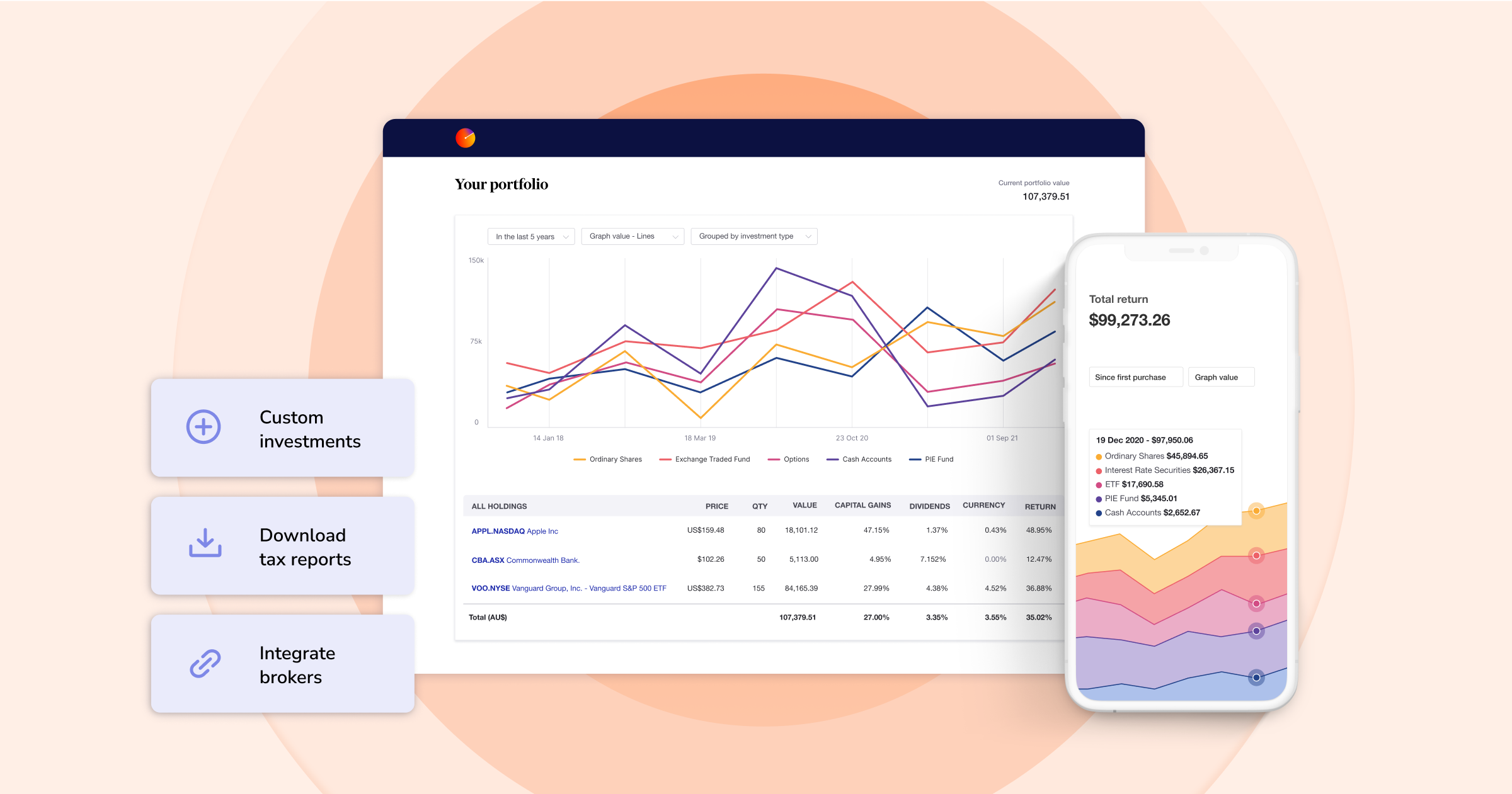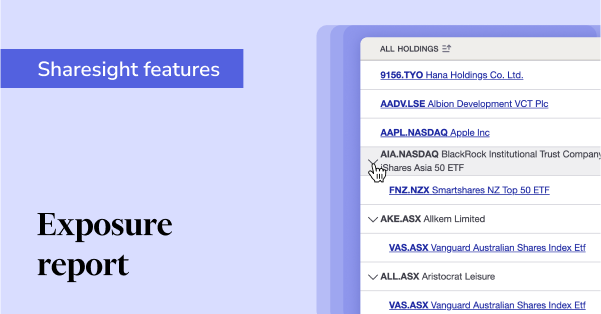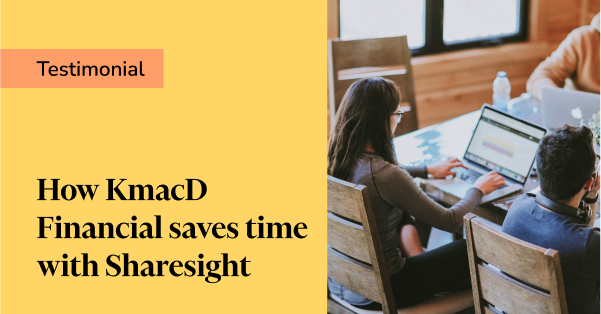Cost base per share vs. average purchase price
One thing we often hear from our customers is that they want an easy way to see the average price they have paid for an investment, as this will help them decide whether they want to purchase more shares or not. Based on this feedback, we’ve introduced ‘average purchase price’ as a value on the portfolio’s individual holdings page. It can be easy to confuse ‘average purchase price’ with ‘cost base per share’, but it’s important to understand that these are two different values that are used for different purposes.
Keep reading to learn exactly what the average purchase price is, how it’s calculated and how it differs from an investment’s cost base per share.

What is the average purchase price?
The average purchase price is an average of the price of all shares an investor has purchased in a particular asset, inclusive of reinvested dividends and adjusted for splits and consolidations. This is calculated from the inception of that holding in the investor’s portfolio. Most importantly, the average purchase price cannot be used for tax purposes – it is simply a quick indicator that investors can use to make decisions about their trades.
It should be noted that the average purchase price does not include:
- Sell trades
- Dividends (except for DRPs)
- Merge buys
- Brokerage fees
- Adjustment for bonuses.
How to calculate average purchase price
As mentioned above, the average purchase price is calculated by taking an average of the price of all shares an investor has bought in an asset. For example, if an investor purchased 20 shares priced at $100 and another 40 shares priced at $150, the average purchase price would be ((20 x 100) + (40 x 150)) / 60 = $133.33
If the stock has undergone a split or consolidation at any point since its inception in your portfolio, that makes calculating the average purchase price a little more complicated, particularly if you are tracking your portfolio manually. For instance, investors who purchased Apple shares before and after 28 August 2020, when there was a 4:1 stock split, must account for this split in their portfolio. From there, the split is taken into consideration in the average purchase price calculations.
Using the screenshot below as an example, the average purchase price would be ((100 x 248.76) + (50 x 132.54) + (50 x 165.81)) / 500 = $79.587
An example of the average purchase price for a series of buy trades in Apple (NASDAQ: AAPL), which underwent a stock split in August 2020.
How to see your average purchase price in Sharesight
It’s easy to see the average purchase price of your investments with Sharesight. Simply click into the individual holding and scroll down to ‘Instrument Detail’ to see the average purchase price of your holding, along with other key information.
Note: At the time of publishing, this feature is in the beta phase. While it is currently only visible in the Instrument Detail section on the Holdings page, we may look to include this value on the Portfolio Overview page in the coming months.
What is the cost base per share?
The cost base of an investment is its original value for tax purposes. This is typically the value of the asset’s purchase price, adjusted for corporate actions including stock splits, dividends and return of capital distributions. It also includes any fees associated with purchasing, holding or selling the asset.
Cost base is used to determine an investment’s capital gain, which is calculated based on the difference between the investment’s cost base and current market value. It’s important to know the cost base (and capital gain) of your investments, particularly if you have sold shares, because this can create tax implications. The cost base per share is simply the investment’s cost base divided by the number of shares held.
When cost base per share is used for tax purposes, it:
- Is converted to the portfolio currency
- Includes brokerage fees
- Takes into account all cost base adjustments
- Is based on the chosen sale allocation method
For more information, please refer to our blog on cost base per share, how it is calculated and where to find this value in your Sharesight portfolio.
Summary
To sum up, a holding’s average purchase price is the average price of all the buy trades an investor has made in a particular asset; whereas the cost base is a value that reflects what it cost you to acquire an asset, including costs associated with purchasing, holding or disposing of the asset. The key difference is that the cost base (or cost base per share) is a value used for tax purposes, while the average purchase price is simply an indicator investors can use to decide whether they want to purchase more shares in an asset.
Track your investment performance with Sharesight
If you’re not already using Sharesight, what are you waiting for? Join hundreds of thousands of investors using Sharesight to track their portfolio and make smarter investment decisions. Sign up today so you can:
- Track all your investments in one place, including stocks in over 40 major global markets, mutual/managed funds, property, and even cryptocurrency
- Automatically track your dividend and distribution income from stocks, ETFs and mutual/managed funds
- Run powerful reports built for investors, including performance, portfolio diversity, contribution analysis, multi-period, multi-currency valuation and future income (upcoming dividends)
- Easily share access to your portfolio with family members, your accountant or other financial professionals so they can see the same picture of your investments as you do
Sign up for a FREE Sharesight account and get started tracking your investment performance (and tax) today.

Disclaimer: The above article is for informational purposes only and does not constitute a specific product recommendation, or taxation or financial advice and should not be relied upon as such. While we use reasonable endeavours to keep the information up-to-date, we make no representation that any information is accurate or up-to-date. If you choose to make use of the content in this article, you do so at your own risk. To the extent permitted by law, we do not assume any responsibility or liability arising from or connected with your use or reliance on the content on our site. Please check with your adviser or accountant to obtain the correct advice for your situation.
FURTHER READING

See what’s inside your ETFs with Sharesight’s exposure report
See inside your ETFs and get the full picture of your investment portfolio's composition with Sharesight's exposure report.

How KmacD Financial streamlines reporting and saves time with Sharesight
We talk to financial planning firm KmacD Financial about how the Sharesight-AdviserLogic integration helps them save time and streamline client reporting.

Sharesight product updates – November 2023
The focus over the past month has been on implementing additional feature ideas relating to our new (beta) exposure report.